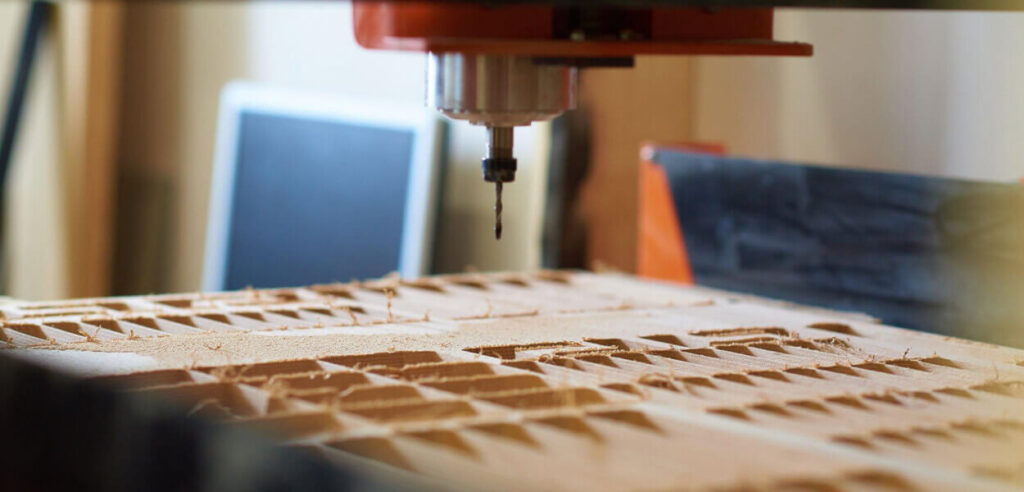Essential CNC Tooling for Wood Mills and Bits for Precision Cutting
In the world of woodworking and manufacturing, precision is paramount. Achieving precision in wood cutting requires the right tools, and CNC technology has revolutionized the way we approach this task. This guide into the realm of CNC tooling for wood mills bits explores the tools that play a pivotal role in achieving precision cuts, efficient operations, and superior woodworking outcomes.

Essential CNC Tooling for Wood Mills and Bits
To achieve precision cuts in wood, a range of CNC tooling options are at your disposal. Here’s a comprehensive look at the essential tooling for optimal results:
End mills designed specifically for wood are versatile tools. With various flute designs and geometries available, they can handle everything from roughing to fine-finishing cuts.
Router bits are indispensable CNC tools for shaping, carving, and engraving wood. They come in various profiles, allowing woodworkers to create intricate designs with ease.
Straight flute bits excel at plunging into the wood and creating clean cuts. They are often used for drilling and routing tasks that require precision and minimal tear-out.
Spiral upcut bits are ideal for chip evacuation and preventing heat buildup during cuts. They are well-suited for softwoods and help achieve clean and smooth cuts.
Compression bits combine upcut and downcut flutes, making them versatile for both entry and exit cuts. They minimize tear-out in materials with varying grain patterns.
Ball nose bits are essential for 3D carving and contouring. They allow woodworkers to create intricate curves, bevels, and detailed designs.
V-Groove Bits
V-groove bits are designed for creating decorative V-shaped grooves, chamfers, and sign-making details. They add an artistic touch to woodworking projects.
For large-scale operations, insert tooling systems offer efficiency and versatility. They allow for quick tool changes, reducing downtime and enhancing productivity.
Diamond-coated bits are used for cutting abrasive materials like MDF, laminates, and composites. Their durability and sharpness make them suitable for high-volume production.
Expert Insights for Optimal CNC Tooling Selection
Material Compatibility: Different wood types have varying hardness and grain patterns. Choose tooling that suits the specific wood you’re working with. Softer woods may require different tooling compared to harder, denser woods.
Cutting Strategy: Determine the type of cuts you’ll be making – roughing, finishing, engraving, etc. Each type of cut may require a different tool or tool geometry. For instance, roughing might benefit from a high-speed, aggressive tool, while finishing demands a tool with a finer edge.
Bit Geometry and Angles: The geometry of the tool, including the number of flutes, helix angles, and edge profiles, affects chip evacuation, surface finish, and cutting speed. Match the bit’s geometry to the task at hand.
Tool Diameter and Depth of Cut: The diameter of the tool determines the achievable level of detail and the size of features you can create. Consider the depth of the cut as well – deeper cuts might require more robust tools.
Tool Coatings: Coatings like TiN (Titanium Nitride) or TiAlN (Titanium Aluminum Nitride) can extend tool life and improve performance by reducing friction and enhancing heat resistance.
Feed and Speed Rates: Proper feed and speed settings are crucial for achieving clean cuts and preventing tool breakage. Consult machining guides provided by tool manufacturers or use CNC software with built-in recommendations.
Tool Runout and Balance: Ensure that the tool holder and collet are properly aligned to minimize tool runout. Imbalanced tools can lead to poor surface finish and premature tool wear.
Dust and Chip Evacuation: Effective dust collection is essential for both safety and tool performance. Accumulated chips can cause overheating and affect cutting quality.
Tooling Budget: While quality tooling can be an investment, it’s important to balance cost with performance and longevity. Higher-quality tools often provide better results and longer lifespans.
Tooling Maintenance: Regularly clean, inspect, and sharpen your tooling. Dull tools not only produce subpar results but also put unnecessary strain on your CNC machine.
Tool Path Optimization: Use CAM (Computer-Aided Manufacturing) software to generate efficient tool paths. This can minimize tool changes, reduce unnecessary movements, and optimize cutting sequences.
Safety Precautions: Always follow safety guidelines when selecting and using tooling. Wear appropriate personal protective equipment and adhere to recommended operating practices.
Experiment and Learn: Don’t be afraid to experiment with different tooling options to find what works best for your specific projects. Learning from experience is a valuable part of becoming proficient in CNC woodworking. ates to precision in cutting.
FAQs
Q: Can I use metal cutting tools for wood machining?
A: While possible, it’s recommended to use tools specifically designed for wood cutting. Wood-specific tooling offers better chip evacuation and smoother cuts.
Q: Which tool is best for intricate wood carving?
A: Ball nose bits are perfect for intricate carving, contouring, and 3D designs due to their rounded shape and precision cutting capabilities.
Q: What factors influence tool selection?
A: Material type, desired finish, cut depth, and machine capabilities are key factors that guide tool selection for precision cutting.
Q: Can CNC tooling be re-sharpened?
A: Some CNC tools can be re-sharpened, extending their lifespan. However, excessive re-sharpening can impact tool geometry and performance.
Q: Is tool runout a concern for precision cutting?
A: Yes, tool runout can lead to inaccuracies in cuts. High-quality collets and tool holders minimize runout and enhance precision.
Q: Are diamond-coated bits suitable for all wood types?
A: Diamond-coated bits are ideal for cutting abrasive materials like MDF and laminates. For standard wood, traditional bits are more appropriate.
Achieving precision cutting in woodworking demands the right tools and expertise. By understanding the spectrum of CNC tooling options available, woodworkers and manufacturers can make informed choices that enhance efficiency, quality, and the overall woodworking experience. From end mills to specialized router bits, each tool serves a unique purpose, contributing to the creation of intricate designs, smooth finishes, and remarkable woodworking projects.








